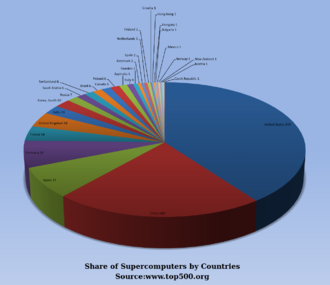Development and trends

In the 2010s, China, the United States, the European Union, and others competed to be the first to create a 1 exaFLOP (1018 or one quintillion FLOPS) supercomputer. Erik P. DeBenedictis of Sandia National Laboratories has theorized that a zettaFLOPS (1021 or one sextillion FLOPS) computer is required to accomplish full weather modeling, which could cover a two-week time span accurately. Such systems might be built around 2030.
Many Monte Carlo simulations use the same algorithm to process a randomly generated data set; particularly, integro-differential equations describing physical transport processes, the random paths, collisions, and energy and momentum depositions of neutrons, photons, ions, electrons, etc. The next step for microprocessors may be into the third dimension; and specializing to Monte Carlo, the many layers could be identical, simplifying the design and manufacture process.
The cost of operating high performance supercomputers has risen, mainly due to increasing power consumption. In the mid 1990s a top 10 supercomputer required in the range of 100 kilowatt, in 2010 the top 10 supercomputers required between 1 and 2 megawatt. A 2010 study commissioned by DARPA identified power consumption as the most pervasive challenge in achieving Exascale computing. At the time a megawatt per year in energy consumption cost about 1 million dollars. Supercomputing facilities were constructed to efficiently remove the increasing amount of heat produced by modern multi-core central processing units. Based on the energy consumption of the Green 500 list of supercomputers between 2007 and 2011, a supercomputer with 1 exaflops in 2011 would have required nearly 500 megawatts. Operating systems were developed for existing hardware to conserve energy whenever possible. CPU cores not in use during the execution of a parallelised application were put into low-power states, producing energy savings for some supercomputing applications.
The increasing cost of operating supercomputers has been a driving factor in a trend toward bundling of resources through a distributed supercomputer infrastructure. National supercomputing centers first emerged in the US, followed by Germany and Japan. The European Union launched the Partnership for Advanced Computing in Europe (PRACE) with the aim of creating a persistent pan-European supercomputer infrastructure with services to support scientists across the European Union in porting, scaling and optimizing supercomputing applications. Iceland built the world's first zero-emission supercomputer. Located at the Thor Data Center in Reykjavík, Iceland, this supercomputer relies on completely renewable sources for its power rather than fossil fuels. The colder climate also reduces the need for active cooling, making it one of the greenest facilities in the world of computers.
Funding supercomputer hardware also became increasingly difficult. In the mid 1990s a top 10 supercomputer cost about 10 million Euros, while in 2010 the top 10 supercomputers required an investment of between 40 and 50 million Euros. In the 2000s national governments put in place different strategies to fund supercomputers. In the UK the national government funded supercomputers entirely and high performance computing was put under the control of a national funding agency. Germany developed a mixed funding model, pooling local state funding and federal funding.
Comments
Post a Comment